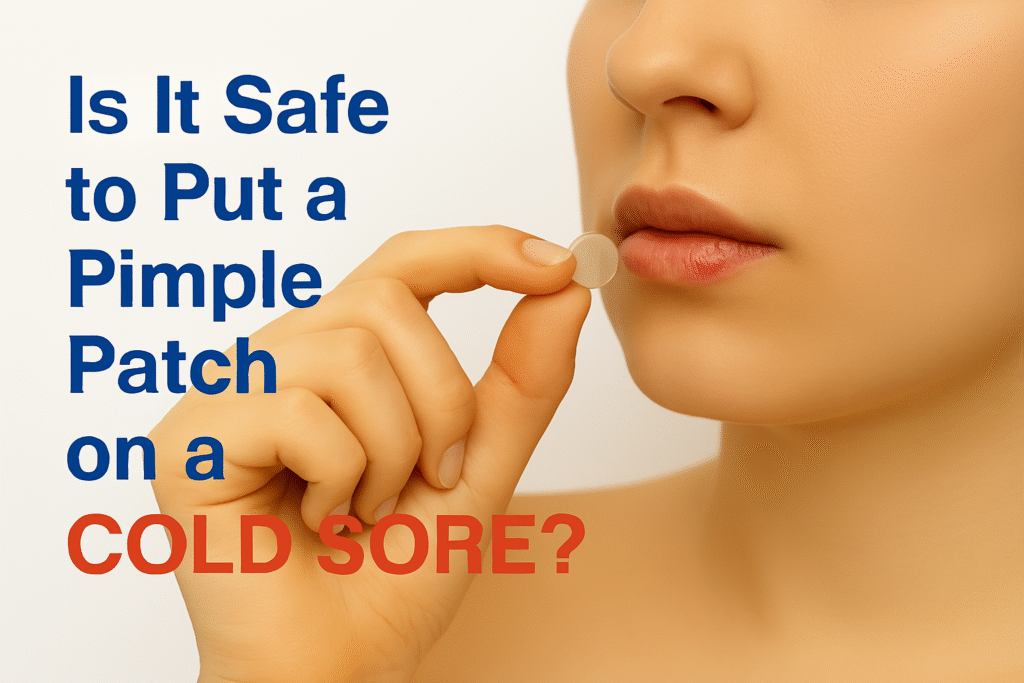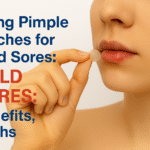
Is It Safe to Put a Pimple Patch on a Cold Sore?
- Pimple patches are designed for acne, not viral cold sores.
- Plain hydrocolloid patches may offer some benefits for cold sores, but medicated acne patches can irritate.
- Dermatologists do not generally recommend pimple patches for cold sores, preferring purpose-made cold sore patches or antiviral treatments.
Understanding Cold Sores vs. Pimples
Cold sores—also called fever blisters—are caused by the herpes simplex virus (usually HSV-1), and usually appear as small, fluid-filled blisters around the lips or mouth. They are highly contagious and need different care than pimples, which result from clogged pores, oil, and bacteria.
While both look similar during the first stage, their causes—and the approaches for safe and fast healing—are quite different.
How Do Pimple Patches Work?
- Main ingredient: Most pimple patches are made from hydrocolloid—a gel-like wound dressing that absorbs pus and fluid from pimples.
- Extra ingredients: Some have acids (like salicylic acid) or tea tree oil meant for acne, not for lips or viral sores.
- Purpose: They work best for protecting pimples from bacteria, blocking picking, and providing a moist environment for faster healing.
Can You Put a Pimple Patch on a Cold Sore?
Technically, yes—you can put a hydrocolloid patch over a cold sore. But is it safe? Experts and dermatologists caution the following:
- Pimple patches are not antiviral and will not shorten a cold sore outbreak.
- Medicated patches for acne (with acids or essential oils) can sting or irritate the delicate skin of a cold sore—even leading to more pain or delayed healing.
- Plain hydrocolloid pimple patches may reduce picking and physical irritation, but are not a substitute for cold sore-specific patches or creams.
- Using any patch could potentially trap extra moisture and bacteria if not changed as directed, possibly slowing healing.
Expert & Dermatologist Views
“First off, you should avoid putting pimple patches on cold sores or other infections…They are generally very safe to use on acne, but for cold sores it’s best to use purpose-made products.”
“Hydrocolloid bandages are safe to use for cold sores and genital herpes outbreaks. They protect, absorb fluid, and can speed healing—but should be plain, with no harsh added actives.”
Some dermatologists do use or recommend hydrocolloid patches for wound care—so a plain patch, with no added actives, can sometimes be used for a cold sore, especially for comfort or public protection. Still, your safest, fastest results come from cold sore-specific patches or medicated creams.
Benefits of Pimple Patches on Cold Sores
- Reduces risk of picking, which is a major cause of infection or scarring.
- Can disguise and protect the sore in public settings (if appearance or social confidence is an issue).
- Helps create a moisture-balanced environment, which may promote healing—if changed often.
| Product/Remedy | Safe for Lips? | Antiviral? | Best Use |
|---|---|---|---|
| Plain Hydrocolloid Pimple Patch | Yes, but use caution—monitor for irritation | No | Covering/blending in public, reducing picking |
| Medicated Pimple Patch (with acids or oils) | No—may sting and worsen cold sore | No | Should be avoided |
| Cold Sore-Specific Patch (hydrocolloid formulated for lips) | Yes—designed for cold sores | No (but speeds healing & blocks irritation) | See-through cover, comfort, healing environment |
| Topical or Oral Antiviral (e.g., acyclovir, valacyclovir) | Yes | Yes—targets virus directly | Start ASAP for best healing |
Risks and Drawbacks
- Skin irritation: Particularly if you use a patch with added actives for acne. Cold sore skin is much more sensitive than normal skin and may react badly.
- False security: A pimple patch doesn’t stop viral spread (you can still transmit HSV-1 to others).
- Possible delayed healing: If moisture is trapped or patch isn’t changed regularly.
- Possible allergic reaction: Always test on a small area first if you have sensitive skin.
How to Use a Patch Safely
- Always clean hands and the area before application.
- Allow the cold sore area to dry thoroughly.
- Apply a plain, non-medicated hydrocolloid patch gently over the cold sore.
- Change the patch every few hours, or when it becomes saturated/opaque.
- Stop using immediately and consult a doctor if you notice greater redness, pain, or swelling.
- Do not use if you have large, open, or actively oozing cold sores—seek medical guidance instead.
Conclusion: Should You Put a Pimple Patch On a Cold Sore?
For most, a plain hydrocolloid pimple patch is technically safe to use on a cold sore, but it isn’t the best or fastest option. Avoid patches with added actives. For true relief and healing, use cold sore-specific patches or antiviral creams, and always consult your doctor if you’re unsure or if you have recurring or severe outbreaks.

